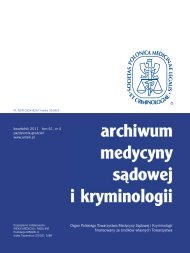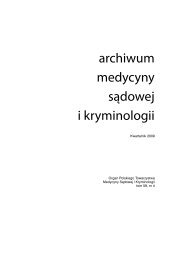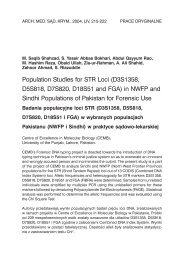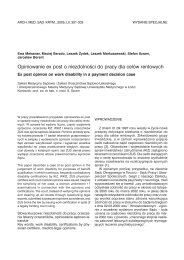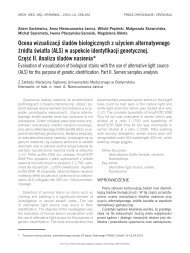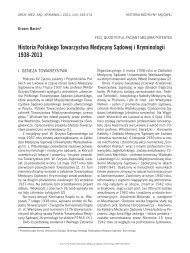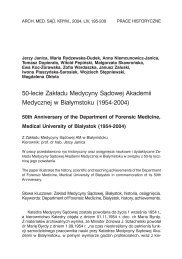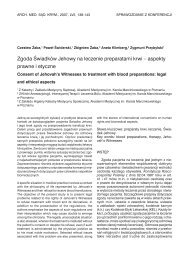PeÅny numer do pobrania (*.pdf) - Archiwum Medycyny SÄ dowej i ...
PeÅny numer do pobrania (*.pdf) - Archiwum Medycyny SÄ dowej i ...
PeÅny numer do pobrania (*.pdf) - Archiwum Medycyny SÄ dowej i ...
Create successful ePaper yourself
Turn your PDF publications into a flip-book with our unique Google optimized e-Paper software.
90 Łukasz Szleszkowski, Agata Thannhäuser, Jerzy Kawecki, Krzysztof Szwagrzyk, Barbara Świątek<br />
Nr 2<br />
Fig. 4. Gunshot injury of the left humerus –N o 32.<br />
Skeleton No. 93: Description of gunshot injuries:<br />
an entrance bullet wound measuring 1.5x0.7 cm in<br />
the anterior surface of the body of the maxilla bordering<br />
the orbit. An exit bullet wound in the left<br />
occipital squama. Event reconstruction: A single<br />
gunshot was fired from the frontal direction to the<br />
face of the condemned, in the suborbital region.<br />
The shot might have been fired from a distance<br />
longer than that characteristic of a contact or close<br />
distance gunshot in view of relatively small<br />
fractures of the cranial bones in the entrance wound<br />
region.<br />
Skeleton No. 108: Description of gunshot injuries:<br />
a multiple gunshot to the head. Entrance<br />
wound I measuring 0.8x0.9 cm is situated within<br />
the right occipital squama. Entrance wound II<br />
measuring 1x0.9 cm is situated in the posterior<br />
part of the right parietal bone, within a small distance<br />
from entrance wound I. Entrance wound III<br />
measuring 0.8x0.9 cm is situated within the mastoid<br />
angle of the left parietal bone. Exit wound I is<br />
situated within the right frontal eminence and exit<br />
wound II – within the glabella. Fractures of the<br />
cranio-facial bones most likely correspond to the<br />
third exit wound. A fissure branches off to the left<br />
side from exit wound II (situated in the glabella region)<br />
and extends almost transversely through the<br />
left lateral part of the frontal squama, without<br />
crossing the vertical fracture fissure that branches<br />
off from exit wound III (in the left mastoid region).<br />
Event reconstruction: Three gunshots were fired at<br />
the condemned. All the three gunshots were fired<br />
from the back aiming at the head. The gunshot to<br />
the parieto-mastoid region – in view of the extent of<br />
concomitant fractures of the cranial bones – might<br />
have been a contact shot or a shot fired from a very<br />
short distance. The gunshots fired to the parietal<br />
and occipital areas might have been fired from a<br />
greater distance in view of absence of extensive<br />
bone fractures in the vicinity of entrance wounds.<br />
The course of fracture fissures that accompanied<br />
the gunshots allows for hypothesizing that the first<br />
gunshot was fired to the left parieto-mastoid region,<br />
and subsequently the others were fired one after<br />
another to the right parieto-occipital region, with<br />
the condemned remaining in approximately the<br />
same position with respect to the shooter (e.g. in<br />
the recumbent position).<br />
Skeleton No. 112: Description of gunshot injuries:<br />
an entrance gunshot wound cannot be completely<br />
delineated, but the arrangement of fracture<br />
fissures and the character of a bone defect allow<br />
for assuming the wound may be situated in the<br />
right interior occipital squama. An exit gunshot<br />
wound is situated within the right parietal bone,<br />
anteriorly to the parietal tuber, with branching off<br />
radial fracture fissures. The bullet wound in the left<br />
inferior part (margin) of the mandibular body extends<br />
crater-like towards the anterior mandibular<br />
surface. A fracture of the transverse process and a<br />
fragment of the vertebral arch C4 that projects on<br />
the mandibular gunshot injuries. While exploring<br />
the grave, inside, at the level of the chest of the<br />
skeleton, a firearm bullet was found. Event reconstruction:<br />
Two gunshots were fired. Both were fired<br />
from the back. One shot was fired to the right parietal<br />
region, with the barrel directed upward with<br />
respect to the cranium of the deceased. The other<br />
gunshot was fired to the area of the neck, what resulted<br />
in hitting the left lateral part of the fourth<br />
cervical vertebra and shooting through the left<br />
mandibular body. The character of the presented<br />
injuries and the presence of a bullet at the chest<br />
level in the grave combined with absence of gunshots<br />
involving other regions of the body allows for<br />
hypothesizing that at the time of being shot at, the<br />
head of the deceased was markedly flexed forward,<br />
with the chin pressing on the sternal region, e.g.<br />
with the deceased kneeling <strong>do</strong>wn and the shooter<br />
standing behind his back. In such a situation, the<br />
shot might have been fired with the barrel axis parallel<br />
to the ground (more ergonomically as com-<br />
2012 © by Polskie Towarzystwo <strong>Medycyny</strong> Są<strong>do</strong>wej i Kryminologii, ISSN 0324-8267



